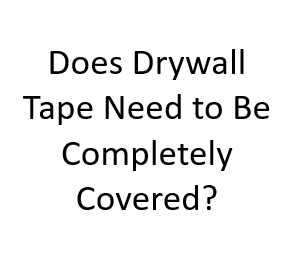When it comes to drywall installation and finishing, one of the common questions that arise is whether drywall tape needs to be completely covered. If you’re a DIY enthusiast or a professional in the construction industry, you’ve probably pondered this question at some point. In this blog post, we’ll delve deep into the world of drywall finishing to uncover the truth about whether drywall tape needs to be completely covered or not.
Understanding Drywall Tape
Before we can answer the question, let’s first understand what drywall tape is and why it’s essential in the construction and finishing of drywall. Drywall tape is a narrow strip of paper or fiberglass mesh that is used to reinforce the joints between drywall sheets. These joints are where two sheets of drywall meet, and they are vulnerable to cracking and shifting over time.
The Purpose of Drywall Tape
The primary purpose of drywall tape is to prevent cracks from forming along the seams of the drywall. Drywall sheets are relatively thin and can easily crack or shift due to temperature changes, settling of the building, or other factors. When joint compound (also known as mud) is applied over the tape, it creates a strong bond that helps to reinforce these seams, making them more durable and less prone to cracking.
Do You Need to Completely Cover Drywall Tape?
Now, let’s address the central question: Does drywall tape need to be completely covered? The answer is yes, and here’s why:
- Structural Integrity: Partially covering drywall tape or leaving it exposed can compromise the structural integrity of the joint. When the tape is not completely covered, it doesn’t provide the necessary reinforcement, leaving the seam vulnerable to cracking and shifting.
- Aesthetics: From an aesthetic standpoint, leaving drywall tape exposed can result in an unsightly finish. The goal of drywall finishing is to create a smooth and seamless surface. Incomplete coverage of the tape can lead to visible ridges or lines, detracting from the overall appearance of the wall or ceiling.
- Durability: Properly covering drywall tape with joint compound ensures the longevity of the wall or ceiling. It prevents moisture from seeping in and protects the tape from wear and tear. This means that a well-covered drywall joint will last longer and require fewer repairs in the future.
How to Properly Cover Drywall Tape
To achieve the best results when covering drywall tape, follow these steps:
- Apply a Base Coat: Begin by applying a base coat of joint compound over the taped seams. Use a 6-inch taping knife for this step. Make sure the tape is fully embedded in the compound, and the edges are feathered out.
- Embed the Tape: Press the tape into the wet compound using your taping knife. Ensure there are no bubbles or wrinkles in the tape. Smooth it out to create a seamless connection between the drywall sheets.
- Add Additional Layers: After the base coat, apply two or more additional layers of joint compound, each wider than the previous one. Feather the edges to blend them with the surrounding drywall. Sand between coats for a smoother finish.
- Sand and Finish: Once the compound is dry, sand the surface to remove any imperfections. Finish with a topcoat of compound for a flawless appearance.
Additional tips and considerations when it comes to working with drywall tape and achieving the best results in your drywall finishing projects:
Use the Right Type of Drywall Tape: There are two common types of drywall tape: paper tape and fiberglass mesh tape. Paper tape is more commonly used for the first layers of joint compound, as it has good adhesion properties. Fiberglass mesh tape is often used for the final layers due to its added strength and resistance to cracking. Choose the type of tape that suits your specific project needs.
Properly Prepare the Surface: Before applying drywall tape, ensure that the surface is clean and free of dust and debris. This will help the tape adhere properly to the drywall. Additionally, it’s a good idea to apply a thin layer of joint compound to the seams before laying down the tape, which is known as “pre-filling.” This creates a smoother base for the tape.
Avoid Overworking the Joint Compound: While it’s important to cover the drywall tape completely, be cautious not to overwork the joint compound. Excessive sanding or smoothing can lead to problems like “flashing,” where the tape becomes visible through the finish coat. It’s essential to find the right balance between smoothing the surface and preserving the tape’s integrity.
Practice Patience: Drywall finishing is a multi-step process that requires patience. Allow each layer of joint compound to dry completely before applying the next one. Rushing through the process can result in a subpar finish and potential issues down the road.
Quality Tools Matter: Invest in high-quality taping knives and sanding tools. Having the right tools can make a significant difference in the ease and quality of your drywall finishing work.
Consider Professional Help: While many homeowners and DIY enthusiasts can tackle drywall projects successfully, some situations may benefit from professional expertise. If you’re dealing with extensive damage, large-scale projects, or if you’re unsure of your skills, it’s wise to consult a professional drywaller to ensure the job is done correctly.
By following these additional tips and best practices, you’ll be well-equipped to tackle your drywall finishing projects with confidence. Remember that achieving a beautifully finished drywall surface is not only about covering the tape but also about the skill and attention to detail you bring to the process. Whether you’re renovating a room or working on a new construction project, a well-executed drywall finish can significantly enhance the overall look and durability of the space.
